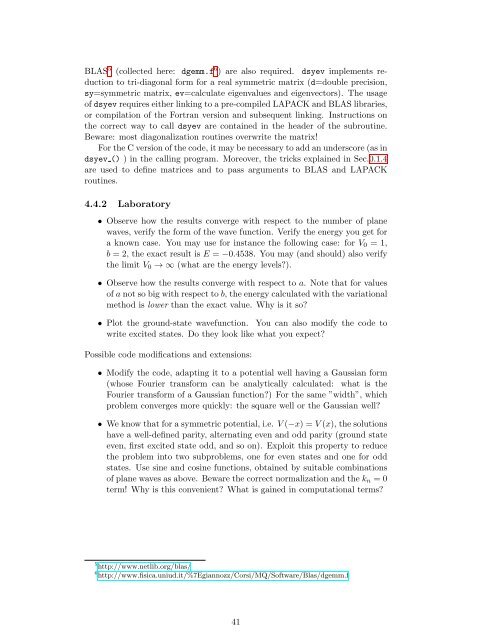Numerical Methods in Quantum Mechanics - Dipartimento di Fisica
Numerical Methods in Quantum Mechanics - Dipartimento di Fisica
Numerical Methods in Quantum Mechanics - Dipartimento di Fisica
You also want an ePaper? Increase the reach of your titles
YUMPU automatically turns print PDFs into web optimized ePapers that Google loves.
BLAS 5 (collected here: dgemm.f 6 ) are also required. dsyev implements reduction<br />
to tri-<strong>di</strong>agonal form for a real symmetric matrix (d=double precision,<br />
sy=symmetric matrix, ev=calculate eigenvalues and eigenvectors). The usage<br />
of dsyev requires either l<strong>in</strong>k<strong>in</strong>g to a pre-compiled LAPACK and BLAS libraries,<br />
or compilation of the Fortran version and subsequent l<strong>in</strong>k<strong>in</strong>g. Instructions on<br />
the correct way to call dsyev are conta<strong>in</strong>ed <strong>in</strong> the header of the subrout<strong>in</strong>e.<br />
Beware: most <strong>di</strong>agonalization rout<strong>in</strong>es overwrite the matrix!<br />
For the C version of the code, it may be necessary to add an underscore (as <strong>in</strong><br />
dsyev () ) <strong>in</strong> the call<strong>in</strong>g program. Moreover, the tricks expla<strong>in</strong>ed <strong>in</strong> Sec.0.1.4<br />
are used to def<strong>in</strong>e matrices and to pass arguments to BLAS and LAPACK<br />
rout<strong>in</strong>es.<br />
4.4.2 Laboratory<br />
• Observe how the results converge with respect to the number of plane<br />
waves, verify the form of the wave function. Verify the energy you get for<br />
a known case. You may use for <strong>in</strong>stance the follow<strong>in</strong>g case: for V 0 = 1,<br />
b = 2, the exact result is E = −0.4538. You may (and should) also verify<br />
the limit V 0 → ∞ (what are the energy levels?).<br />
• Observe how the results converge with respect to a. Note that for values<br />
of a not so big with respect to b, the energy calculated with the variational<br />
method is lower than the exact value. Why is it so?<br />
• Plot the ground-state wavefunction. You can also mo<strong>di</strong>fy the code to<br />
write excited states. Do they look like what you expect?<br />
Possible code mo<strong>di</strong>fications and extensions:<br />
• Mo<strong>di</strong>fy the code, adapt<strong>in</strong>g it to a potential well hav<strong>in</strong>g a Gaussian form<br />
(whose Fourier transform can be analytically calculated: what is the<br />
Fourier transform of a Gaussian function?) For the same ”width”, which<br />
problem converges more quickly: the square well or the Gaussian well?<br />
• We know that for a symmetric potential, i.e. V (−x) = V (x), the solutions<br />
have a well-def<strong>in</strong>ed parity, alternat<strong>in</strong>g even and odd parity (ground state<br />
even, first excited state odd, and so on). Exploit this property to reduce<br />
the problem <strong>in</strong>to two subproblems, one for even states and one for odd<br />
states. Use s<strong>in</strong>e and cos<strong>in</strong>e functions, obta<strong>in</strong>ed by suitable comb<strong>in</strong>ations<br />
of plane waves as above. Beware the correct normalization and the k n = 0<br />
term! Why is this convenient? What is ga<strong>in</strong>ed <strong>in</strong> computational terms?<br />
5 http://www.netlib.org/blas/<br />
6 http://www.fisica.uniud.it/%7Egiannozz/Corsi/MQ/Software/Blas/dgemm.f<br />
41
















